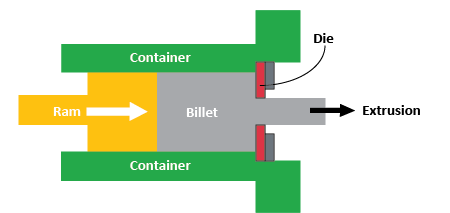Aluminum Extrusion
What is Aluminum Extrusion?
Aluminum extrusion is the process of forcing aluminum alloy material through a die with a defined shape. The heating of the billet (a cast log of aluminum) causes it to become soft but still solid. As it is pressed against the die it becomes wider and eventually it is forced to squeeze through the shape or profile of the die. It emerges on the other side as a fully formed shape.

What are the Benefits of Aluminum Extrusions?
- Lightweight
Aluminum is lightweight, weighing less then steel, copper, brass or iron. This makes aluminum easier to handle, cheaper to ship and ideal for products where weight reduction is a focus.
- Non-sparking
Aluminum extrusions are safe for applications where the environment could be highly flammable or if the application is close to explosive materials.
- Corrosion resistant
The aluminum surface is protected by its own naturally occurring surface oxidation which prevents rust. This protection can be further strengthened by anodizing or other finishing processes.
- Strength
Aluminum becomes stronger in colder temperatures, which makes aluminum extrusions ideal for cold-weather applications. Strength can be added to specific areas of the part through die design. Different wall thicknesses or internal reinforcements can be applied.
Aluminum extrusions high strength and low weight combination makes them ideal for applications such as aerospace, truck trailers, automotive, etc.
- Non-magnetic, Noncombustible, Nontoxic
Aluminum will not acquire a magnetic charge, does not burn, and does not produce toxic fumes.
- Design Flexibility
The ability to design a profile to meet specific functional, aesthetic, and manufacturing objectives makes aluminum extrusions a preferred element in many product solutions. Profiles can be complex or very simple.
- Sustainable
Aluminum is one of the most environmentally friendly metals on the planet. It is recycled more then any other industrial metal and can be recycled infinitely with no reduction in properties. Aluminum extrusions can be made with high recycled content as there is no compromise to aesthetics or functionality.
What are Aluminum Extrusions used for?
You will come into contact with aluminum extrusions every day; in school, at the office, during transit, at the playground, at the mall. Aluminum extrusions are everywhere. At Kromet, we specialize in aluminum extrusions which are highly decorative and functional. Handles, ladders and assemblies for appliances, structural and decorative furniture components, running boards, roof racks and battery boxes for cars and trucks, LED lighting parts, wall partition's, and bumper products for recreational vehicles are just a few of the applications where Kromet aluminum extrusions are used.










Types of Aluminum Alloys
An aluminum alloy is a chemical composition where other elements such as iron, silicon, copper, magnesium, manganese or zinc can be added to pure aluminum to enhance its properties.
- 6XXX Series
Kromet works predominately with the 6XXX series. It is a versatile alloy which is made up of silicon and magnesium which form magnesium silicide in the alloy. It is heat treatable, easily formed, weldable, has a moderately high strength and excellent corrosion resistance.
- Other Alloys
If you have any questions on other types of aluminum alloys do not hesitate to contact us and we would be happy to provide you with more information.
What Sized Parts Can Kromet Extrude?
Kromet presses can accommodate sizes up to 6.75" in diameter, with the option to expand the width to 10.25" using a butterfly device. Use of the butterfly device does reduce the height of the part to 0.68" with ends no more then 1.25" high. Extruded parts can be as long as 28ft.
What Kinds of Shapes Can Be Extruded?
There are countless shapes which can be created with aluminum extrusion and there are three types of dies used to create these shapes. Dies can be solid, semi-hollow, or hollow.
- Solid Dies
Solid dies are used to create shapes that do not contain enclosed shapes or openings, for example: LED lighting channels, furniture support beams, etc. There are three categories of solid dies: flat-face, pocket, and feeder dies.
- Hollow Dies
Hollow dies are used to create shapes that have one or more enclosed shape or void. Think a rectangular tube, t-slots, etc. Hollow dies are typically made up of two interlocking pieces: the mandrel which forms the internal profile and the cap which forms the external profile.
- Semi-Hollow Dies
Semi-hollow dies also have open voids but they are not fully enclosed. Semi-hollow dies often require more complex designs to ensure there is no breakage and to lengthen the dies life.
Why are Aluminum Extrusions Treated with Heat?
Alloys in the 2000, 6000, and 7000 series can be heat treated to enhance their ultimate tensile strength and yield stress. To achieve these enhancements, profiles are put into ovens where the aging process is accelerated and they are brought to the T5 or T6 tempers. How do their properties change? As an example, untreated 6061 aluminum (T4) has a tensile strength of 241 MPa (35000 psi). Heat-treated 6061 aluminum (T6) has a tensile strength of 310 MPa (45000 psi).
What types of surface finishes are available?
Kromet offers both anodizing and powder paint in-house.
